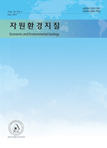Structural analysis of the Danyang area, Danyang coalfield, Korea
- 대한자원환경지질학회
- 자원환경지질
- 25권 1호
-
1992.0261 - 72 (12 pages)
- 46

단양지역은 단양탄전 서남부에 위치하며, 습곡작용과 드러스트 단층운동을 받은 중생대와 고생대 지층들로 구성되어 있다. 연구지역은 대규모의 조구조선, 동으로는 옥동단층과 서쪽에는 각동 드러스트 단층으로 경계지워져 있다. 연구지역내에 발달하고 있는 지질구조 요소들을 해석한 결과 연구지역내의 지층들이 4번에 걸쳐서 변형작용을 받았다. 옥동단층을 따라서 발달하고 있는 압쇄대는 첫번째 변형작용(D₁) 중에 형성되었으며, 이와 관련된 구조로는 장산규암층내에 불연속적으로 발달하고 있는 압쇄대와 조서누층군내의 지층에 평행하게 발달한 인장(引長, pull-apart)구조들이 관찰된다. 두번째 변형작용중에 형성된 지질구조(D₂)로는 북서방향의 습곡구조와 선구조들이며, 이러한 구조들은 대동 누층군 내에서는 관찰되지 않는다. 한반도 전역에 영향을 준 대보조산운동의 결과로 형성된 지질 구조들로는 (D₃) 각동 드러스트를 비롯한 북동방향의 드러스트 단층들과 습곡구조 등이다. 이 기간 동안에 기존의 지질구조들은 더 tight해졌으며, 변형되고 북동방향으로 회전되었다. 최후기의 변형작용(D₄) 중에 동-서 방향의 죽령단층과 미약한 습곡구조가 형성되었다. 죽령단층내의 지층들은 주향이동 단층운동중에 회전되고 transpression의 영향을 받았다.
The Danyang area consists of the thrust and folded sedimentary rocks of Paleozoic and Mesozoic Era. The area is bounded by major tectonic units which are the Gagdong Thrust to the west and the Okdong Fault to the east. According to the structural analyses, the area is affected by polyphase deformation. This study establishes deformational sequence in the area. Mylonite zone along the Okdong Fault corresponds to the first generation of structures (D₁). D₁-structures are discrete shear zone in the Jangsan Formation and bedding parallel extensional deformation in the Cambro-Ordovician sequences. D₂-structures were formed prior to the sedimentation of the Jurassic Bansong Group, which are the NW-trending fold and linear structures. After sedimentation of the Bansong Group, the area is strongly affected by the Daebo Orogeny which produces NE-trending thrusts, folds and linear structures. Earlier structures were tightened and rotated toward NE. Some thrust faults did not propagate into the Bansong Group. It is suggested either the Bansong Group acted as a decoupling horizon or rest on unconformably on the thrust faults. The area is weakly affected by D₄-event of which structures are E-W trending folds and faults. The Jugryeong Fault clearly cut the earlier folds and thrust faults. The rocks within the fault zone were sliced and rotated during the strike-slip movements. Block rotation and transpressional features can be commonly observed.
ABSTRACT
INTRODUCTION
GEOLOGY
DESCRIPTION OF MAJOR THRUST FAULTS AND FAULTS
GELOGICAL STRUCTURES
DEFORMATIONAL SEQUENCE
DISCUSSION
CONCLUSION
REFERENCES
요약
(0)
(0)